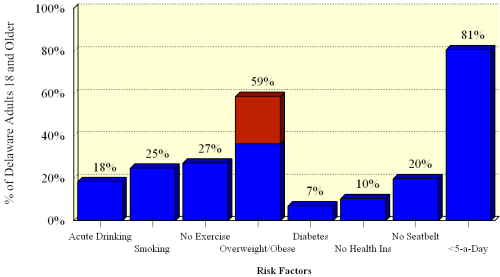Major Behavioral Risk Factors

Source: Delaware Health and Social Services, Division of Public Health,
Behavioral Risk Factor Surveillance System (BRFSS), 2002.
Selected behavioral risk factors for adult Delaware residents are shown in the graph above. They are risk factors for the leading causes
of illness, injury and premature death in our state.
-
Acute drinking, commonly called "binge drinking," is a major risk factor for unintentional injuries –
especially from vehicle crashes. In 2002, about 18% of adults admitted to drinking more than 5 drinks on one occasion during the past
month.
- The prevalence of cigarette smoking by Delaware adults has remained essentially unchanged – at 25% –
during the past decade. Smoking causes almost one-third of all cancers, and is a major cause of heart disease, stroke, emphysema and
other lung disease.
- About 27% of adults in our state get no physical activity. Lack of physical activity is a risk factor for overweight
and obesity, which cause heart disease and type 2 diabetes.
-
Overweight and obesity are major health risks, and the trend has been increasing toward higher
prevalence of obesity since the Delaware BRFSS began collecting data. The BRFSS asks height and weight, and uses those numbers to
compute Body Mass Index (BMI). A BMI of 25 - 29.9 for most people indicates significant overweight, and a BMI of 30 or greater is
considered "obese." In 2002, almost 60% of adult Delawareans were either overweight or obese.
- The prevalence of diabetes in Delaware has risen from 4.3% in 1995 to 7.1% in 2002.
- About one in 10 adult Delawareans reported that they had no health insurance.
- In 2002, about 20% said they do not use seatbelts regularly when driving or riding in a car. In 2003, Delaware
passed a law requiring safety restraint use by the driver and all passengers. The new law also allows law officers to stop cars if they
see anyone in the vehicle not wearing a seatbelt and shoulder harness. In 2004, the BRFSS will again measure safety belt use to determine
the impact of the new law.
- Healthy eating is an essential part of disease prevention and weight control. One of the best indicators of healthy diet is
consumption of fruits and vegetables. In 2002, the overwhelming majority of adults – 81% – did
not eat the recommend minimum of five servings of fruits and vegetables daily.
General Health Status
Individuals who respond to the survey generally believe they are in good health, even though they may report significant risks factors
which endanger their future health. To many people, the absence of current illness is considered "good health." The BRFSS
asks: "Would you say that in general your health is excellent, very good, good, fair or poor?"
Their answers:
|
Excellent
|
Very Good
|
Good
|
Fair
|
Poor
|
|
21.6%
|
34.6%
|
29%
|
11.1%
|
3.7%
|
Young adults generally believe they're in better health than older adults. For example, only 6.9% of 18-24 year-old respondents say
they're in "fair or poor" health, but 29.3% of adults 65 and older say they're in "fair or poor"
health. The challenge in education is to demonstrate that health is more than the absence of disease, and that reducing risk
factors now can improve health and quality of life significantly – now and in the future.
